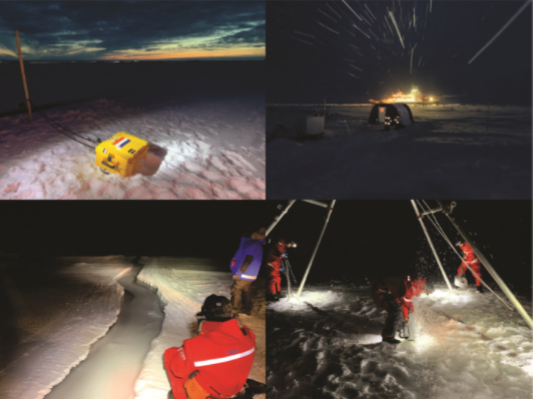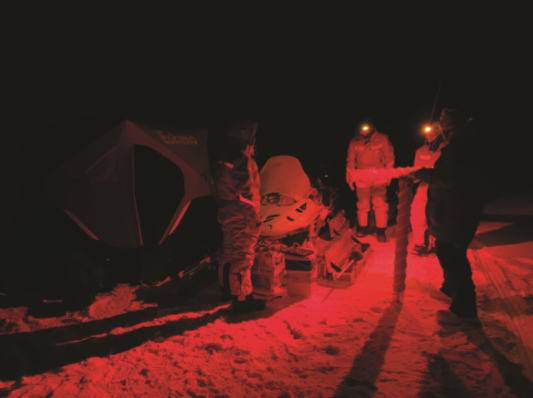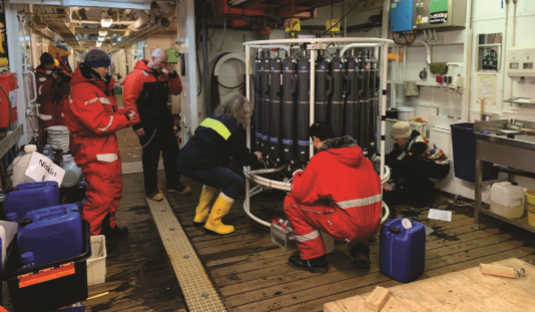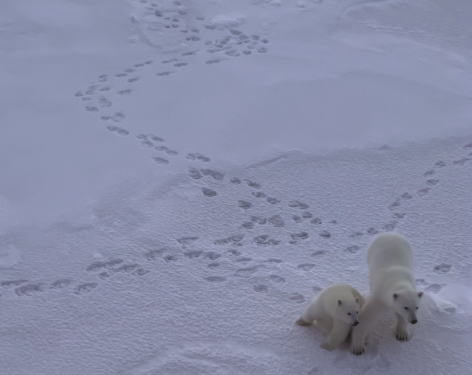MOSAiC Blog: Moving Over to the ‘Dark Site’ of the MOSAiC Floe
Published: 1 December 2019

Editor’s note: Jessie Creamean, a research scientist at Colorado State University, is participating in the Multidisciplinary Drifting Observatory for the Study of Arctic Climate (MOSAiC) expedition, which started September 20, 2019. Creamean is blogging for ARM about her MOSAiC journey. All photos and captions are by Creamean except where indicated.
Surrounded by the darkness and ice … one would think I encountered Darth Vader on Hoth. But nope, I am currently at 86 degrees north latitude on a massive chunk of ice floating around the Arctic Circle.
It has been about a month and a half since I have had the chance to write a blog. Life has been bustling on the Polarstern, with a wide range of scientific measurements taking place from 4,400 meters (about 14,400 feet) below the sea ice (15 meters, or almost 50 feet, above the sea floor) to the top of the troposphere. Since I have relocated from the Akademik Fedorov to the Polarstern, MOSAiC is in full swing.
First and foremost … polar bears. A little cuter than wampas and probably not as stinky as banthas (I really hope most of you reading this are “Star Wars” fans). I had an interview on “BBC Breakfast”—it’s like “Good Morning America” in the U.K.—before leaving port from Norway, and polar bears were the topic of conversation. We have had a few curious bears encountering our central observatory and “play” with scientific sensors at some of our remote sites. Luckily, no bad encounters, and everyone (including the bears!) have remained safe.
Another challenge of working in the Arctic: cracks in the ice. When I first arrived at the ice floe that is now what I am calling home, there were a number of large cracks that had formed, including one right near a site called Met City. These cracks have been about a meter wide and, at times, spread for several tens of kilometers long. I was able to deploy my portable aerosol sampler, named C3PO, in hopes of measuring aerosols that help form clouds and that originate from these cracks. Luckily, C3PO operated successfully at temperatures well below zero!


Recently, we had a lead—a very, very large crack—open up near the vessel during a particularly windy storm event, so hopefully my aerosol sampler on board in the DOE ARM container is measuring particles that come from the sea spray. My first week here, I also helped set up an automated trap connected to a buoy that will collect sediment deep in the ocean for the next year. This was done out at what we call our “dark site,” which is a location over 1 kilometer (0.6 mile) from the Polarstern where we core for ice. When I say it, it immediately makes me think of “Star Wars” (ahem, the dark side). There was an incredible effort for setting up on the ice—the met towers, the buoys, the ice sensors, the huts that house a wide array of instruments … you name it, it is out there.
Speaking of ice, I am a part of the 12-person ice coring crew that goes out every Monday to collect almost 60 ice cores from ice that had just formed this year (about a half-meter thick, or 1.6 feet) to ice from last year with ice from this year formed on top of it (almost 1 meter thick, or about 3 feet). Every coring day, we set up a tent, and each of us has a special job to minimize our time out in the bitter cold, although collecting, cutting, and bagging all the cores still takes us five to six hours.
The job is not done after we come in from the ice. The different teams, including my ecology (ECO) team, the biogeochemical team, and sea ice team, take their set of cores and process them. For the ECO team, that means melting over 40 different segments of ice cores to then separate the ice melt into almost 100 bottles for different types of filtering and sampling … all while in a cold room and using only red headlights (like, lightsaber-colored red) so as not to disturb the microbiology, since microbes can be stimulated by bright white light. I am the “ice boss,” meaning I am in charge of determining what core segment goes where and is parsed for which analyses. The results? We hope to have a comprehensive set of biological, chemical, and physical measurements in the vertical profile of the ice, including the particles I study, called ice-nucleating particles, which are essentially seeds for cloud ice formation. The whole ice core process takes three long days.
We also look at different parameters in the ocean water column using a large instrument called a CTD rosette (CTD stands for conductivity, temperature, and depth). This crucial piece of equipment houses numerous sensors and 24 bottles that open at different depths of the ocean, collecting 12 liters (3.2 gallons) of seawater samples at desired depths. It takes a large team of ship crew and scientists for a successful CTD cast.
After the CTD takes a dive in the ocean through a large hole in the ice, and after we partake in our synchronized sampling dance around the rosette, I take some of the samples I collect and analyze them on instruments that tell us how much methane and oxygen are in the seawater for some of my colleagues back in the U.S. This information is important because it gives insight into how the microbes process such gases and how those gases might exchange with the atmosphere.

So why do I give a hoot about all these kinds of samples and data for my aerosol-cloud research? Well, in order to measure aerosols in the air and to model how they might affect clouds in the future, we need to understand where they come from. My theory is that a lot of the aerosols we see in the Arctic come from the biology in the snow, ice, and ocean. In order to prove that, I link what I see in my aerosol samples to the samples I collect from ice cores, CTDs, and snow pits, and use supporting biological and chemical data to tell the story of what kinds of microbes were present and what exactly they were doing.
Well, back to the sample analysis and preparation for the next coring day at the dark site in my cozy, warm lab. More like Tatooine in here than the Hoth that exists outside … until next time!

Keep up with the Atmospheric Observer
Updates on ARM news, events, and opportunities delivered to your inbox
ARM User Profile
ARM welcomes users from all institutions and nations. A free ARM user account is needed to access ARM data.


















